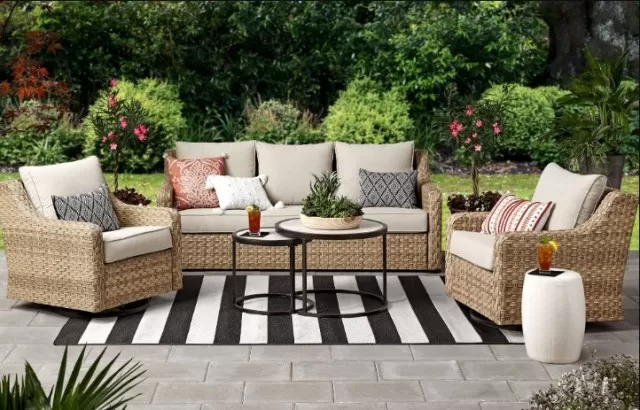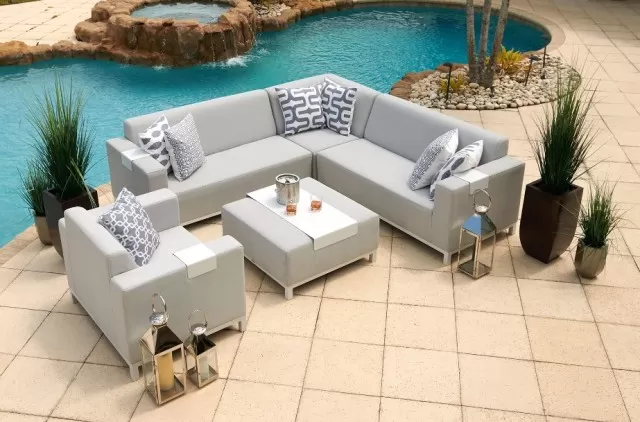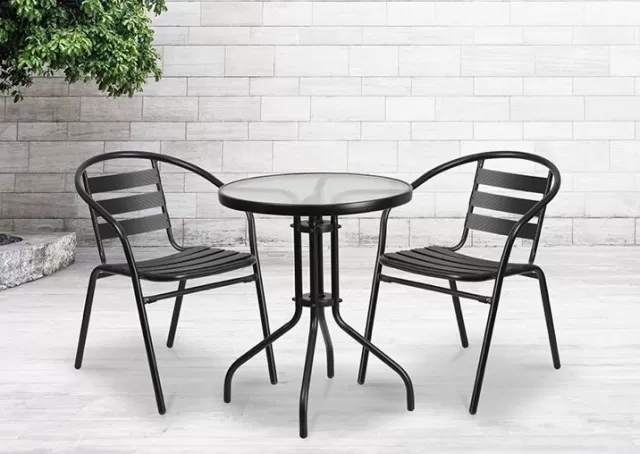Maintaining the cleanliness of your Outdoor Furniture is essential to ensure a pleasant seating experience and enjoyable dining.
Regular cleaning is necessary to keep your furniture in excellent condition.
For optimal results, it is recommended to clean outdoor furniture four times a year: once at the beginning and end of summer, and a couple of times in between. The appropriate cleaning method depends on the material of your patio furniture.
We have provided guidelines on how to clean wood, wicker, metal, glass, and plastic furniture, ensuring that these tips will revitalize your patio furniture. To prevent further weathering and staining, it’s advisable to store the furniture indoors during the winter season.
Wood and Wicker Outdoor Furniture

To revive and clean dull or dirty wood or wicker furniture, follow these straightforward cleaning methods.
Start by using a mild oil-based soap, like Murphy Oil Soap, mixed with warm water to remove grime. Alternatively, you can create a DIY cleaning solution by combining 1/4 cup of ammonia, 2 tablespoons of white vinegar, and 1 quart of warm water.
Commercial wood cleaners are also effective, but be sure to carefully read the instructions. For wicker and painted wood, it may be necessary to dilute the cleaning solution.
To protect your patio furniture, regularly wipe down the wood to eliminate dirt, debris, and excess water.
Hardwood furniture can benefit from an annual sanding and the application of a fresh protective finish coat, such as oil, stain, or polyurethane. Additionally, hose down wicker furniture every few weeks to prevent dirt from building up in crevices.
Metal, Iron, and Aluminum Outdoor Furniture

Proper cleaning is crucial to maintain the shine of outdoor metal furniture.
For aluminum pieces, oxidation is a common issue. Before cleaning, try to remove as much oxidation as possible using a metal polishing paste or a solution of white vinegar and water (in a 1:1 ratio).
Avoid using chemicals like ammonia and trisodium phosphate (TSP) as they can cause oxidation.
To preserve the natural luster of metal furniture:
Wash aluminum furniture frequently and remove scuff marks with a soft cloth and a non-abrasive cleaning product.
Address rust by sanding it off along with any damaged paint. Wipe off metal residue with a cloth dampened with mineral spirits or naphtha.
Use a rust-resistant primer before applying rust-resistant paint for a fresh coat. Consider sandblasting or powder-coating wrought-iron furniture for added protection.
Apply a coat (or two for iron) of automotive wax after cleaning to maintain its condition.
Glass Patio Furniture

Keep your glass patio tables sparkling with these simple cleaning steps.
Start by removing any stuck-on debris with a glass-safe, non-abrasive cleanser, and a cloth or sponge. Be cautious with scrub brushes, as they can scratch the glass.
Opt for brushes specifically designed for tough cleaning jobs that won’t damage your furniture.
Dish detergent and home Cleaning Solutions are effective for cleaning glass surfaces.
After the initial cleaning, spray white vinegar or glass cleaner onto the surface and wipe it away with a microfiber cloth or paper towel. It’s important to wipe down the underside of the glass table at least once a month to prevent stubborn grime buildup.
Clean the frames of glass tables based on the material they are made of.
To keep outdoor glass furniture clean, it’s advisable to cover the glass table when it’s not in use.
Minor scratches and chips in the glass can be addressed with a glass repair kit if needed.
Plastic and Hard-Resin Outdoor Furniture

Follow these tips to remove stains and built-up grime from plastic patio chairs and tables:
Create a mild cleanser by mixing 1/2 cup of baking soda with 1 gallon of warm water.
For tougher stains, mix 3 tablespoons of dishwasher detergent (which contains a mild bleaching agent) with 1 gallon of warm water. For colored plastic, mix 1/4 cup of vinegar with 1 quart of warm water.
Avoid using chlorine and bleach on white plastic furniture, as they can damage the material. For stubborn stains, dampen a clean rag with white distilled vinegar and wipe down the piece.
You can also sprinkle baking soda on a wet sponge to create a mild abrasive that will remove stains without scratching the surface. Avoid using abrasive cleaners that could damage plastic outdoor furniture.
After washing the plastic furniture, protect it with a coat of automotive paste wax.
*The information is for reference only.